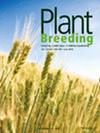六倍体三尖杉(×三尖杉马蒂尼)三个先进品系的减数分裂配对及形态和产量特征研究
IF 1.8
4区 农林科学
Q2 AGRONOMY
引用次数: 0
摘要
野生大麦(Hordeum chilense Roem et. Schultz)与硬质小麦(Triticum turgidum L. ssp.硬粒小麦(HT)具有有趣的农艺性状,可以移植到栽培小麦中。多年来,已培育出多个 HT 品系并对其进行了鉴定。对于具有多代自交系的先进 HT 品系来说,基因组稳定性和繁殖力是可期待的。在这项工作中,我们以 H. chilense 的基因组 DNA 和克隆的面包小麦 rDNA 序列 pTa71 为探针,通过荧光原位杂交(FISH)分析了三株六倍体三叶小麦高级品系(HT9、HT31 和 HT67)花粉母细胞(PMC)中的减数分裂染色体配对情况,并对成年植株连续三年的九个形态和产量相关性状进行了表征。不出所料,所有 HT 品系都表现出规则的减数分裂染色体配对,确保了植株的繁殖力,这一点已在前几代成株的形态和产量相关性状表征中得到证实。在全球范围内,三叶草对小麦育种很有意义,具有作为替代作物的潜力。本文章由计算机程序翻译,如有差异,请以英文原文为准。
Meiotic pairing and morphological and yield characterisation of three advanced lines of hexaploid tritordeum (×Tritordeum martini)
Hexaploid tritordeum [×Tritordeum martinii A. Pujadas (Poaceae) nothosp. nov.; Hch Hch AABB] resulted from crosses between wild barley (Hordeum chilense Triticum turgidum H. chilense
求助全文
通过发布文献求助,成功后即可免费获取论文全文。
去求助
来源期刊

Plant Breeding
农林科学-农艺学
CiteScore
4.40
自引率
5.00%
发文量
74
审稿时长
3.0 months
期刊介绍:
PLANT BREEDING publishes full-length original manuscripts and review articles on all aspects of plant improvement, breeding methodologies, and genetics to include qualitative and quantitative inheritance and genomics of major crop species. PLANT BREEDING provides readers with cutting-edge information on use of molecular techniques and genomics as they relate to improving gain from selection. Since its subject matter embraces all aspects of crop improvement, its content is sought after by both industry and academia. Fields of interest: Genetics of cultivated plants as well as research in practical plant breeding.
 求助内容:
求助内容: 应助结果提醒方式:
应助结果提醒方式:


